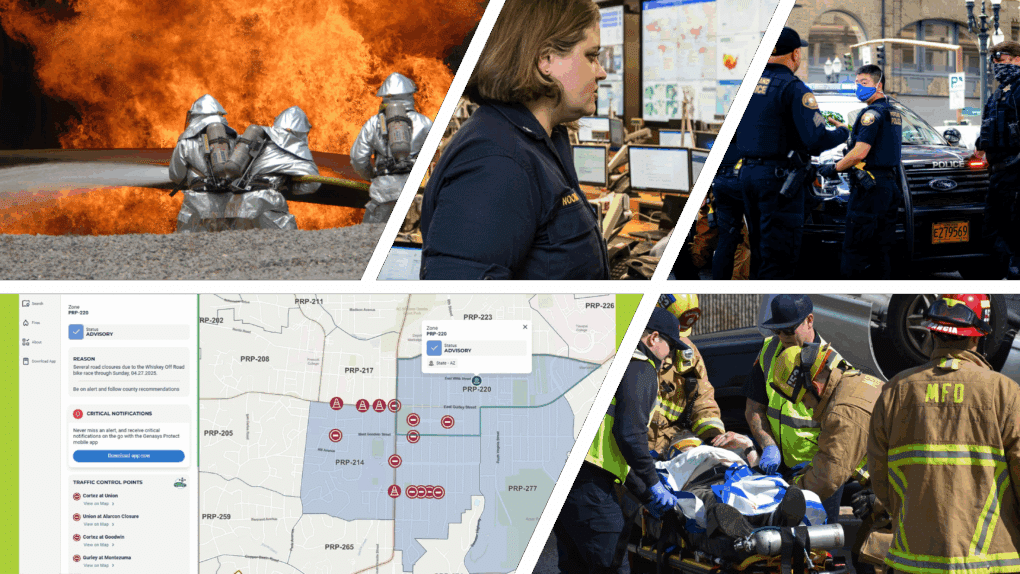By Tynan Heller, Senior Product Manager, Genasys Inc.
Emergency managers, weather scientists, and GIS experts have been using modeling to forecast potential hazards and disasters for many years. But what if the ability to model wildfires became an integrated tool available within an evacuation communication platform – one that could be updated in real-time and shared in seconds either before or during an actual emergency event or as part of an after-action review?
Wouldn’t that take your evacuation efforts to the next level instantly?
Predicting Wildfire Behavior
To effectively predict a wildfire’s behavior, you need to factor in multiple key components to increase safety for the public and first responders, as well as reduce property risk and damage. This can include:
- Wind speed and direction
- Slope, fuel, and topography
- Fire intensity and duration
- Size of the impacted area
With this information and an integrated wildfire simulation and evacuation modeling solution, your team can overcome the challenges often faced during an emergency.
The Benefits of Forest Fire Simulation Before an Actual Event
Wildfire simulations are highly beneficial in the planning and training phase of operations. A strong, accurate modeling tool allows emergency managers and first responders to essentially ask “What if?” questions and plan for a variety of different circumstances.
Simulations help agencies stress-test evacuation and response plans, exposing weak points or bottlenecks. For instance, they can show how quickly evacuation routes might clog in a fast-moving wildfire, prompting planners to set up alternative routes or staging areas. Simulating extreme weather, like high winds or sudden shifts, gives emergency teams insight into real-time impacts on fire spread and containment. These tests guide adjustments in resource allocation, communication timelines, and mutual aid, ensuring plans can handle diverse scenarios.
To create strong plans using simulation technology, it is important to identify and account for hyper-local information such as:
- At risk populations and infrastructure
- Facilities specializing in hazardous or combustible materials
- Facilities housing highly vulnerable populations requiring specialized evacuation support, such as hospitals, senior care facilities, prisons, unhoused populations, etc.
- Potential traffic flow concerns
- Shelters, lodging, food and water stations, and emergency stockpiles
Ways That Wildfire Simulation Can Support Evacuations
Wildfires move quickly and can be totally unpredictable, or at the very least, dependent on even moderate changes in the weather. There are some inherent challenges during a wildfire evacuation that can leave an emergency responder team with no clear vision forward.
With top tier wildland fire simulation at your fingertips, you gain an evacuation communications tool that can be shared with mutual aid partners where these issues can be minimized if not eradicated all together. This would change or avoid the following:
- Misdirection of resources, planning, and operational missteps while trying to reduce risks to firefighters and emergency personnel.
- Relying solely on in-the-field expertise when anticipating a wildfire’s course or path and its impact on evacuating citizens. Regardless of training people can make mistakes, and supporting predictions with simulations can account for data that people cannot process all at once.
- Breakdowns in evacuation logistics – communications, transportation, traffic routing, and resource allocation, such as shelters for residents, pets, and livestock.
Wildfire Modeling that Keeps People Safe
With an emergency evacuation solution, like Genasys EVAC, a cloud-based software platform with critical communications and modeling capabilities, emergency responders can successfully simulate a wildfire’s progression and overlay it onto a pre-built zone-based map of the area of operations.
This allows agencies and communities to run predictive simulations providing for targeted evacuations, safer conditions, and allowing more time for people to get to safety. Couple that with zone-specific incident information and communications and a state-of-the-art mass notification system to fully realize a dynamic solution that manages wildfire evacuations in real time.
Taking Your Wildfire Simulations to the Next Level
Creating a single, unified operations picture with advanced modeling capabilities is possible with Genasys EVAC.
Contact Genasys to learn more about our All-Hazards Early Warning & Emergency Notifications solutions and schedule a demo today with one of our experts.

















